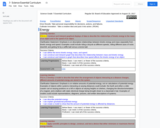
7th Grade Regular Science Scope & Sequence
- Subject:
- Life Science
- Physical Science
- Material Type:
- Full Course
- Provider:
- Liberty Public Schools
- Date Added:
- 08/15/2017

7th Grade Regular Science Scope & Sequence

This assignment is about exploring alternative ways of sharing goods and services and understanding the benefits, drawbacks, and implications of these methods. Students are asked to choose one of seven non-market distribution methods, such as majority rule, contests, force, first-come/first-served, sharing equally, lottery, and personal characteristics, and observe how it is implemented in real-life scenarios. They need to explain the distribution method, who benefits from it, who is excluded, and the advantages and disadvantages of using it. Students also have to find a real-life example of the chosen non-market distribution method, describe how it is used, and assess its fairness and efficiency. Lastly, they are required to include a citation and ensure their submission is no less than 180 words and comprises a list of cited works. The goal of the assignment is to better understand how goods and services are distributed and how these methods affect different groups of people.
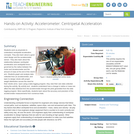
Students work as physicists to understand centripetal acceleration concepts. They also learn about a good robot design and the accelerometer sensor. They also learn about the relationship between centripetal acceleration and centripetal force governed by the radius between the motor and accelerometer and the amount of mass at the end of the robot's arm. Students graph and analyze data collected from an accelerometer, and learn to design robots with proper weight distribution across the robot for their robotic arms. Upon using a data logging program, they view their own data collected during the activity. By activity end , students understand how a change in radius or mass can affect the data obtained from the accelerometer through the plots generated from the data logging program. More specifically, students learn about the accuracy and precision of the accelerometer measurements from numerous trials.
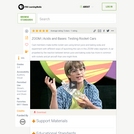
A car propelled by the reaction between lemon juice and baking soda has more in common with rockets and jet aircraft than one might think. In this video segment adapted from ZOOM, two cast members demonstrate the power of rocket-propelled vehicles and how to exploit the force produced by the carbon dioxide gas. Grades 3-8.
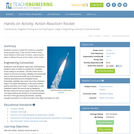
Students construct rockets from balloons propelled along a guide string. They use this model to learn about Newton's three laws of motion, examining the effect of different forces on the motion of the rocket.
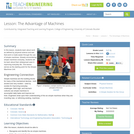
In this lesson, students learn about work as defined by physical science and see that work is made easier through the use of simple machines. Already encountering simple machines everyday, students will be alerted to their widespread uses in everyday life. This lesson serves as the starting point for the Simple Machines Unit.
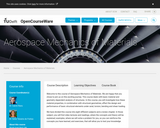
Welcome to this course of Aerospace Mechanics of Materials. We are happy that you chose to join us on this exciting journey. This course deals with basic material and geometry dependent analysis of structures. In this course, you will investigate how these material properties, in combination with structural geometries, affect the design and performance of basic structural elements under axial, torsion, bending and shear loading.
We have divided this course into eight different subjects and a review chapter. In those subject, you will find video lectures and readings, where the concepts and theory will be explained; examples, where we will solve a problem for you, so you can reinforce the concepts you have learned; and exercises, that will allow you to test your knowledge.
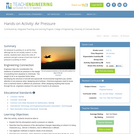
Air pressure is pushing on us all the time although we do not usually notice it. In this activity, students learn about the units of pressure and get a sense of just how much air pressure is pushing on them.
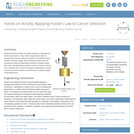
Students explore Hooke's law while working in small groups at their lab benches. They collect displacement data for springs with unknown spring constants, k, by adding various masses of known weight. After exploring Hooke's law and answering a series of application questions, students apply their new understanding to explore a tissue of known surface area. Students then use the necessary relationships to depict a cancerous tumor amidst normal tissue by creating a graph in Microsoft Excel.
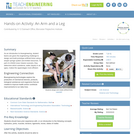
As an introduction to bioengineering, student teams are given the engineering challenge to design and build prototype artificial limbs using a simple syringe system and limited resources. As part of a NASA lunar mission scenario, they determine which substance, water (liquid) or air (gas), makes the appendages more efficient.

Students learn how forces are used in the creation of art. They come to understand that it is not just bridge and airplane designers who are concerned about how forces interact with objects, but artists as well. As "paper engineers," students create their own mobiles and pop-up books, and identify and use the forces (air currents, gravity, hand movement) acting upon them.
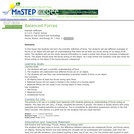
This lecture/activity on force will further a students' understanding of forces on an object, as well as the difference between a balanced and unbalanced forces.
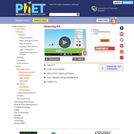
Play with objects on a teeter totter to learn about balance. Test what you've learned by trying the Balance Challenge game.
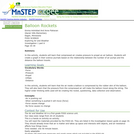
This activity is a hands-on investigation that teaches students that air resitance affects how things move and that pressure from compressed air can move things.
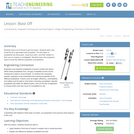
Rockets need a lot of thrust to get into space. In this lesson, students learn how rocket thrust is generated with propellant. The two types of propellants are discussed and relation to their use on rockets is investigated. Students learn why engineers need to know the different properties of propellants.
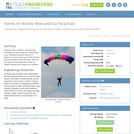
Students make a skydiver and parachute contraption to demonstrate how drag caused by air resistance slows the descent of skydivers as they travel back to Earth. Gravity pulls the skydiver toward the Earth, while the air trapped by the parachute provides an upward resisting force (drag) on the skydiver.
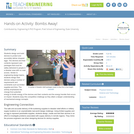
Students design and build devices to protect and accurately deliver dropped eggs. The devices and their contents represent care packages that must be safely delivered to people in a disaster area with no road access. Similar to engineering design teams, students design their devices using a number of requirements and constraints such as limited supplies and time. The activity emphasizes the change from potential energy to kinetic energy of the devices and their contents and the energy transfer that occurs on impact. Students enjoy this competitive challenge as they attain a deeper understanding of mechanical energy concepts.
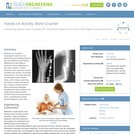
Students use a tension-compression machine (or an alternative bone-breaking setup) to see how different bones fracture differently and with different amounts of force, depending on their body locations. Teams determine bone mass and volume, calculate bone density, and predict fracture force. Then they each test a small animal bone (chicken, turkey, cat) to failure, examining the break to analyze the fracture type. Groups conduct research about biomedical challenges, materials and repair methods, and design repair treatment plans specific to their bones and fracture types, presenting their design recommendations to the class.
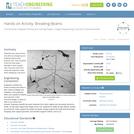
Students learn about stress and strain by designing and building beams using polymer clay. They compete to find the best beam strength to beam weight ratio, and learn about the trade-offs engineers make when designing a structure.
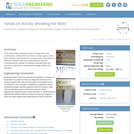
In this math activity, students conduct a strength test using modeling clay, creating their own stress vs. strain graphs, which they compare to typical steel and concrete graphs. They learn the difference between brittle and ductile materials and how understanding the strength of materials, especially steel and concrete, is important for engineers who design bridges and structures.